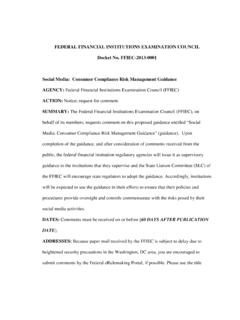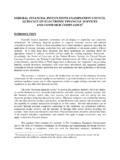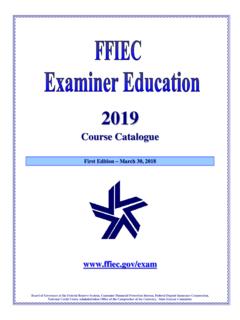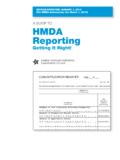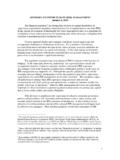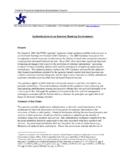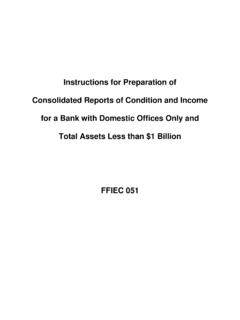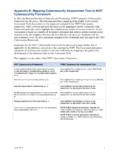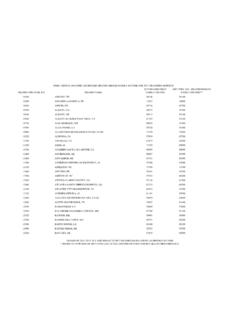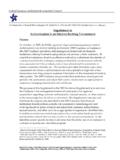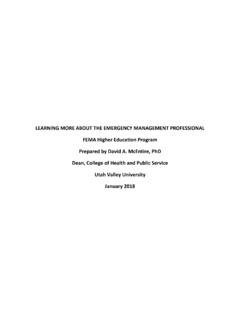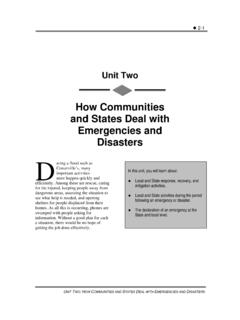Transcription of Management - Federal Financial Institutions Examination ...
1 FFIEC Information Technology Examination Handbook Management NOVEMBER 2015 FFIEC IT Examination Handbook Management November 2015 1 Contents INTRODUCTION .. 3 I .. GOVERNANCE .. 4 IT Governance .. 4 Board of Directors Oversight .. 4 IT Management .. 6 Enterprise Architecture .. 9 IT Responsibilities and Functions .. 10 IT Risk Management Structure .. 10 Information Security .. 10 Project Management .. 11 Business Continuity .. 12 Information Systems Reporting .. 12 Planning IT Operations and Investment .. 14 Other Functions .. 18 II .. RISK Management .. 20 Operational Risk .. 20 III .. IT RISK Management .. 21 Risk Identification .. 22 Ongoing Data Collection .. 22 Risk Measurement .. 24 Risk Mitigation .. 26 Policies, Standards, and Procedures .. 27 Personnel.
2 27 Information Security .. 28 Business Continuity .. 30 Software Development and Acquisition .. 31 IT Operations .. 31 Insurance .. 32 Third-Party Management .. 34 Monitoring and Reporting .. 36 FFIEC IT Examination Handbook Management November 2015 2 Metrics .. 36 Performance Benchmarks .. 37 Service Level Agreements .. 37 Policy Compliance .. 37 Effectiveness of Controls .. 38 Quality Assurance and Quality Control .. 38 Reporting .. 38 APPENDIX A: Examination PROCEDURES .. 40 APPENDIX B: GLOSSARY .. 57 APPENDIX C: REFERENCES .. 63 FFIEC IT Examination Handbook Management November 2015 3 Introduction The Management booklet is one of 11 booklets that make up the Federal Financial Institutions Examination council (FFIEC) Information Technology Examination Handbook (IT Handbook). The Management booklet rescinds and replaces the June 2004 version.
3 This booklet provides guidance to examiners and outlines the principles of overall governance and, more specifically, IT governance. Additionally, this booklet explains how risk Management is a component of governance and how IT risk Management (ITRM) is a component of risk Management . This booklet describes the interaction of these components. The Examination procedures in this booklet assist examiners in evaluating the following: IT governance as part of overall governance in Financial Institutions . Processes for ITRM as part of risk Management in Financial IT supports most aspects of a Financial institution s business; therefore, effective ITRM is not limited to technology. The IT department typically manages back-office operations, network administration, and systems development and acquisition, and is involved in business continuity and resilience, and third-party Management .
4 IT Management provides expertise in choosing and operating technology solutions for an institution s lines of business ( , commercial credit and asset Management ) or for enterprise-wide activities ( , security and business continuity planning). IT Management is critical to the performance and success of a Financial institution. ITRM involves more than containing costs and controlling operational risks and does not work in isolation. A Financial institution capable of aligning its IT infrastructure to support its business strategy adds value to the institution and positions itself for sustained success. Financial Institutions face many challenges in today s marketplace, including cybersecurity threats, increasing the need for effective IT Management and ITRM. An institution s IT systems may connect with affiliates, customers, internal lines of business, third parties ( , third-party providers2), and the public.
5 IT creates interdependencies among infrastructure, applications, and Web content. These interdependencies affect the decision-making process necessary to support existing products and services and provide for the delivery of new products and services. Timely, accurate, and secure information is critical to meeting business requirements throughout the institution. T echnology evolves rapidly, requiring enhancements to existing systems and prompting new investment in infrastructure, systems, and applications. New technology requires expertise, which creates competition for the necessary 1 The term Financial institution includes national banks, Federal savings associations, state savings associations, state member banks, state nonmember banks, and credit unions, as well as technology service providers that provide services to such entities.
6 The term is used interchangeably with institution in this booklet. This booklet may refer to technology service providers specifically in cases where the agencies do not mean to include Financial Institutions . 2 Third-party providers, also called third-party service providers, include technology service providers or other third parties that perform critical business activities for or on behalf of an institution. FFIEC IT Examination Handbook Management November 2015 4 talent, knowledge, and skill sets. ITRM includes addressing new sources of risk that arise with new or evolving technology. I Governance Action Summary Financial institution boards of directors should oversee, while senior Management should implement, a governance structure that includes the following: Effective IT governance. Appropriate oversight of IT activities.
7 Comprehensive IT Management , including the various roles played by Management . Effective enterprise architecture. Governance refers to how Financial Institutions manage and control their institution. Governance provides the structure through which an institution sets and pursues objectives while taking into account the regulatory and market environment and culture of the institution. The governance structure specifies the responsibilities for the board of directors, managers, auditors, and other stakeholders and specifies the level of authority and accountability for decision making. Governance also includes mechanisms for monitoring actions and decisions enterprise-wide. IT Governance IT governance is an integral part of governance and consists of the leadership and organizational structures and processes that ensure that the organization s IT sustains and extends the organization s strategies and objectives.
8 3 IT governance objectives are to ensure that IT generates business value for the institution and to mitigate the risks posed by using technology. Board of Directors Oversight The board of directors sets the tone and direction for an institution s use of IT. The board should approve the IT strategic plan, information security program, and other IT-related policies. To carry out their responsibilities, board members should understand IT activities and risks. The board or a board committee should perform the following: Review and approve an IT strategic plan that aligns with the overall business strategy and includes an information security strategy to protect the institution from ongoing and emerging threats, including those related to cybersecurity. 3 Board Briefing on IT Governance, 2nd edition, IT Governance Institute, 2003.
9 FFIEC IT Examination Handbook Management November 2015 5 Promote effective IT governance. Oversee processes for approving the institution s third-party providers, including the third parties Financial condition, business resilience, a nd IT security posture. Oversee and receive updates on major IT projects, IT budgets, IT priorities, and overall IT performance. T he board of directors may need to approve critical projects and activities, such as expanding the institution s product line to include mobile Financial services. Oversee the adequacy and allocation of IT resources for funding and personnel. Approve policies to escalate and report significant security incidents to the board of directors, steering committee, government agencies, and law enforcement, as appropriate. Hold Management accountable for identifying, measuring, and mitigating IT risks.
10 Provide for independent, comprehensive, and effective audit coverage of IT controls. The board may delegate the design, implementation, and monitoring of specific IT activities to Management or a committee ( , IT steering committee). An IT steering committee4 generally comprises senior Management and staff from the IT department and other business units. Committee members do not have to be department heads, but members should understand IT policies, standards, and procedures (collectively, policies5). Each member should have the authority to make and be held accountable for decisions within their respective business units. If the institution has a formal risk Management function, risk Management staff should participate in an advisory capacity. The steering committee typically is responsible for reporting to the board on the status of IT activities.
